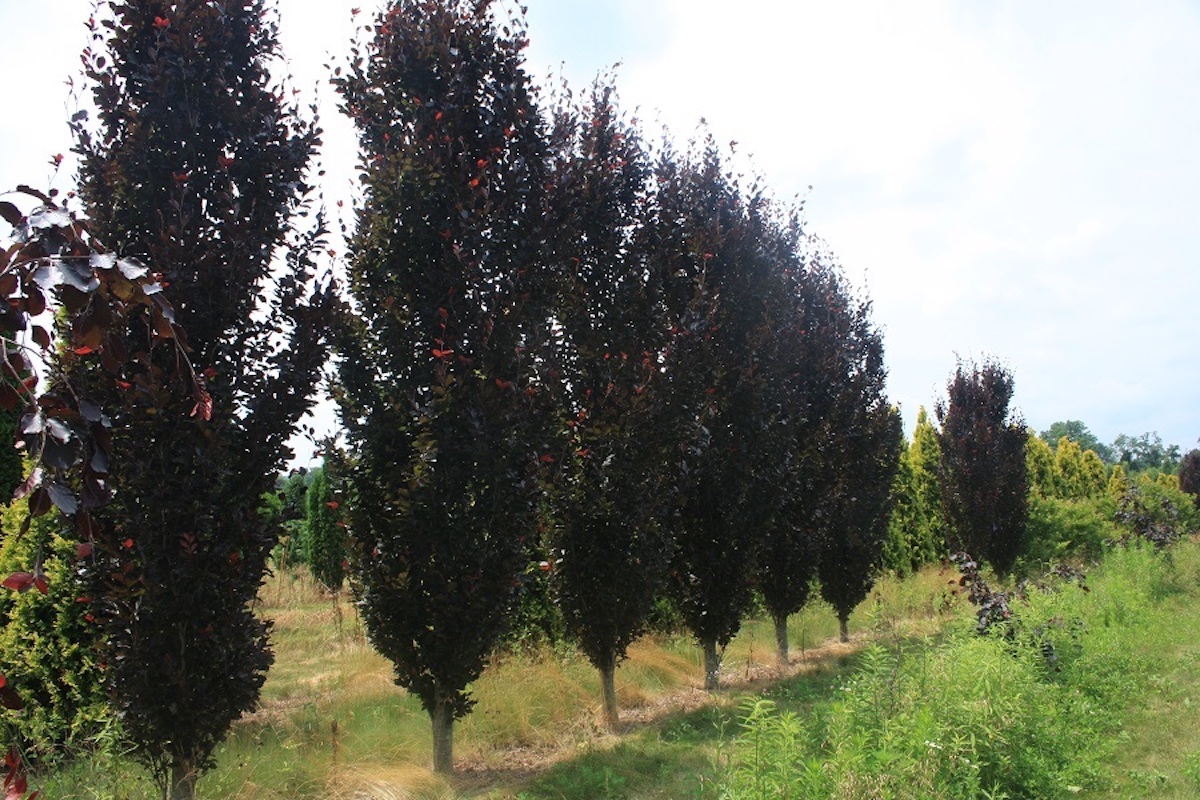The Fagus sylvatica ‘Red Obelisk’ is a stunning variety of European beech that brings vibrant color and unique form to gardens and landscapes. With its narrow columnar shape and deep reddish-purple foliage that persists all season, it makes a dramatic vertical accent.
Overview of the Red Obelisk Beech
This exciting beech cultivar was discovered in Germany in the 1960s. Key facts
- Botanical Name: Fagus sylvatica ‘Red Obelisk’
- Mature Height: 35-50 feet
- Mature Width: 8-10 feet
- Growth Rate: Slow, reaches 10-12 feet in first 10 years
- Form: Narrow columnar shape
- Foliage: Deep reddish-purple leaves all season
- Fall Color: Coppery bronze tones
The compact upright habit and rich coloring distinguish it from the species The dark burgundy leaves last spring through fall, unlike most trees.
Ornamental Features
Beyond its narrow form, the Red Obelisk beech offers:
-
Vibrant purple foliage – The crinkled leaves emerge a deep reddish-purple in spring, keeping this hue all summer without fading. The dark leaves contrast the silver-gray trunk.
-
Graceful ascending form – Its strongly columnar shape stands apart from rounded canopies. Lower branches sweep upward.
-
Fall color – Leaves transition to coppery-bronze in autumn before dropping Color is brighter in colder climates
-
Winter interest – Branch structure and silver bark add interest after leaves fall.
-
Low maintenance – Very hardy once established with minimal pest or disease problems. Needs little pruning.
The striking dark purple foliage provides year-round beauty. It makes a dramatic narrow vertical accent or focal point.
Growth Habit
Unlike the widespread canopy of European beech, the Red Obelisk has:
-
Upright branching forming a narrow pyramid.
-
Dense foliage concentrated near the leader, open at base.
-
Lower branches may sweep ground but can be trimmed for clearance.
-
Slow growth, reaching 10-12 feet in first decade, maturing around 35-40 feet tall and only 8-10 feet wide.
-
Takes 20+ years to fully mature. Long lived like the species.
The columnar habit allows it to fit tight spots where width is limited.
Care and Growing Conditions
The Red Obelisk adapts well to various conditions:
-
Sun – Full sun for deepest color, but tolerates some shade. Needs good sunlight.
-
Soil – Thrives in moist, well-draining soil. Tolerates varying textures. Avoid soggy soils.
-
pH range – Flexible from 5.5 to 8.0.
-
Watering – Regular initially, reduce frequency with maturity. Prefers moist soil.
-
Hardiness – Zones 4-7, quite cold hardy. Some susceptibility to late spring freezes when young.
-
Maintenance – Occasional pruning when young to shape. Otherwise carefree once established.
Avoid extremes of wet or dry soil. It is sensitive to soil compaction and pollution near roads or structures. Site carefully.
Uses in Landscape Design
Thanks to its versatile size and form, the Red Obelisk beech works well:
-
As an accent or specimen tree
-
A vertical element along borders or beds
-
A living screen or hedge to divide spaces
-
An allee lining a driveway or entrance
-
In containers on patios or terraces
Its compact size suits urban gardens and small yards. It naturally fits formal, elegant designs by adding vertical interest and color. For full effect, plant against a light wall to contrast the purple foliage.
Potential Issues
Aside from some sensitivity to soil conditions, the Red Obelisk beech is relatively trouble-free:
-
Monitor for powdery mildew, especially in damp climates. Usually not severe enough for treatment.
-
Can get minor leaf miners causing browning between veins. Mostly cosmetic damage.
-
May occasionally get aphids, scale, or caterpillars. Easily controlled if needed.
-
Possible leaf scorch on hot sites. Afternoon shade helps prevent this.
With proper siting and care, this is a very low maintenance specimen. It has no serious pest or disease problems.
The Red Obelisk European beech is a gorgeous narrow tree with deep purple foliage. It works wonderfully in formal and modern gardens, providing eye-catching vertical interest and vibrant color all season. Once established, this slow-growing beech requires minimal care for lasting beauty.

How to use Red Obelisk Beech in the landscape?
Plant Red Obelisk at the corners of your house to frame your home and add curb appeal or plant a row of these long-lived trees along your property line to create a sensational seasonal privacy screen for posterity.
Hardiness Zone: 4-7
How To Plant Red Obelisk Beech
Give Red Obelisk Beech a home in full sun to bring out the deepest purple-red color in its foliage. In hot summer weather, the color may fade a bit to a bronzy green. Beeches don’t like soggy soil, so good drainage is a must, and regular irrigation is important during the first few years of establishment. Once it’s settled in, Red Obelisk will be somewhat drought tolerant. Mulch your tree well and keep under-plantings to a minimum, as this tree—like other Beeches—is shallow-rooted. There are no major pests or diseases associated with this stellar low-maintenance tree.
Immediately after planting, give your new Red Obelisk Beech a deep and thorough watering. You should water every three to four days slowly and thoroughly for the first growing season.
When planting, mis the Bower & Branch Starter Plant Food into the hole, surrounding the rootball with the fertilizer. For ongoing care, you should fertilize each spring and fall for the first three years.
Due to its slow growth habit and columnar upright growth, pruning may not be needed. If you prefer to keep it more uniform, you should prune when the tree is dormant, ideally late winter to early spring.
